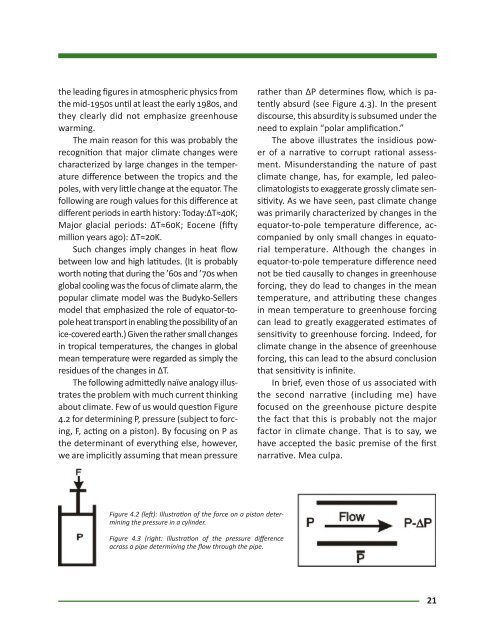The Climate Surprise
The-Climate-Surprise_CO2C-New-Criterion-1
The-Climate-Surprise_CO2C-New-Criterion-1
You also want an ePaper? Increase the reach of your titles
YUMPU automatically turns print PDFs into web optimized ePapers that Google loves.
the leading figures in atmospheric physics from<br />
the mid-s unl at least the early s, and<br />
they clearly did not emphasize greenhouse<br />
warming.<br />
<strong>The</strong> main reason for this was probably the<br />
recognion that major climate changes were<br />
characterized by large changes in the temperature<br />
difference between the tropics and the<br />
poles, with very lile change at the equator. <strong>The</strong><br />
following are rough values for this difference at<br />
different periods in earth history: Today:∆T≈K;<br />
Major glacial periods: ∆T≈K; Eocene (fiy<br />
million years ago): ∆T≈K.<br />
Such changes imply changes in heat flow<br />
between low and high latudes. (It is probably<br />
worth nong that during the ’s and ’s when<br />
global cooling was the focus of climate alarm, the<br />
popular climate model was the Budyko-Sellers<br />
model that emphasized the role of equator-topole<br />
heat transport in enabling the possibility of an<br />
ice-covered earth.) Given the rather small changes<br />
in tropical temperatures, the changes in global<br />
mean temperature were regarded as simply the<br />
residues of the changes in ∆T.<br />
<strong>The</strong> following admiedly naïve analogy illustrates<br />
the problem with much current thinking<br />
about climate. Few of us would queson Figure<br />
. for determining P, pressure (subject to forcing,<br />
F, acng on a piston). By focusing on P as<br />
the determinant of everything else, however,<br />
we are implicitly assuming that mean pressure<br />
rather than ∆P determines flow, which is patently<br />
absurd (see Figure .). In the present<br />
discourse, this absurdity is subsumed under the<br />
need to explain “polar amplificaon.”<br />
<strong>The</strong> above illustrates the insidious power<br />
of a narrave to corrupt raonal assessment.<br />
Misunderstanding the nature of past<br />
climate change, has, for example, led paleoclimatologists<br />
to exaggerate grossly climate sensivity.<br />
As we have seen, past climate change<br />
was primarily characterized by changes in the<br />
equator-to-pole temperature difference, accompanied<br />
by only small changes in equatorial<br />
temperature. Although the changes in<br />
equator-to-pole temperature difference need<br />
not be ed causally to changes in greenhouse<br />
forcing, they do lead to changes in the mean<br />
temperature, and aribung these changes<br />
in mean temperature to greenhouse forcing<br />
can lead to greatly exaggerated esmates of<br />
sensivity to greenhouse forcing. Indeed, for<br />
climate change in the absence of greenhouse<br />
forcing, this can lead to the absurd conclusion<br />
that sensivity is infinite.<br />
In brief, even those of us associated with<br />
the second narrave (including me) have<br />
focused on the greenhouse picture despite<br />
the fact that this is probably not the major<br />
factor in climate change. That is to say, we<br />
have accepted the basic premise of the first<br />
narrave. Mea culpa.<br />
Figure 4.2 (le): Illustraon of the force on a piston determining<br />
the pressure in a cylinder.<br />
Figure 4.3 (right: Illustraon of the pressure difference<br />
across a pipe determining the flow through the pipe.<br />
21


